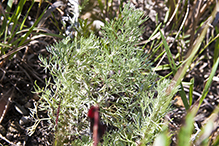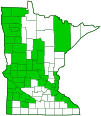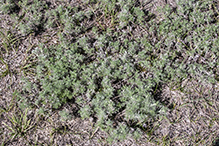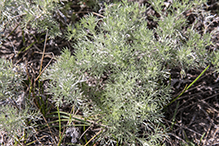prairie sagewort
(Artemisia frigida)
Conservation • Description • Habitat • Ecology • Use • Distribution • Taxonomy
Conservation Status |
|
|||||||
| IUCN Red List | not listed |
|||||||
| NatureServe | NNR - Unranked SNR - Unranked |
|||||||
| Minnesota | not listed |
|||||||
Description |
||
Prairie sagewort is an erect, long-lived, perennial forb that rises on up to 24 stems from a woody caudex. It forms a low mound or densely tangled, interwoven mass (mat). Like most Artemisia species, the leaves and stem are strongly aromatic when bruised. It produces both flowering stems and non-flowering, vegetative stems. The lower stems are vegetative, short, often branched, woody, and spreading. The upper stems are flowering, herbaceous, and erect. They can be from 4″ to 24″ tall, but are usually no more than 16″ in height. The stems are densely covered with short, grayish-white, woolly or felty hairs, giving them a grayish-green appearance. Leaves are deciduous and 3 ⁄16″ to ⅝″ long or longer. Lower leaves are on short leaf stalks, upper leaves are stalkless. There is often a pair of stipule-like lobes or leaflets at the base of the leaf stalk. The leaf blades are deeply divided into 3 primary lobes (ternate). The primary lobes may be divided into 3 secondary lobes (biternate), which may be again divided into 3 lobes (triternate). The ultimate lobes are narrowly linear, often thread-like, 1 ⁄64″ to 1 ⁄16″ wide, and are mostly sharply pointed at the tip. The upper and lower surfaces are densely covered with short, woolly or felty hairs, giving them a grayish-green appearance. The margins are untoothed and usually rolled under. The inflorescence is an elongated, leafy, branched cluster (panicle) of at the end of the stems and branches. The panicles are 1½″ to 6″ long or longer, 3 ⁄16″ to ¾″ wide or wider, and have numerous flower heads. The flower heads are ¼″ in diameter. The whorl of bracts at the base of the flower head (involucre) is globe-shaped, about 3 ⁄16″ long and wide, and 1 ⁄16″ to ⅛″ high. The bracts of the involucre are in 2 or 3 overlapping rows, often indistinct, and moderately to densely covered with woolly hairs. The inner series of bracts have broad, thin, papery, transparent margins and tip. There are no ray florets. The disk has female (pistillate) florets as well as florets that have both male and female parts (perfect). On the margin of the disk are 10 to 17 pale yellow, pistillate florets. In the center are 20 to 50 pale yellow, perfect florets. The receptacle is covered with relatively long, soft, shaggy but unmatted hairs between the florets. The fruit is a tiny achene. |
||
Height |
||
4″ to 16″ |
||
Flower Color |
||
Pale yellow |
||
Similar Species |
||
|
||
Habitat |
||
Dry. Prairies, fields, meadows, cliffs. Full sun. |
||
Ecology |
||
Flowering |
||
July to September |
||
Pests and Diseases |
||
|
||
Use |
||
|
||
Distribution |
||||
|
Sources |
|||
| 5/28/2023 | ||||
Nativity |
||||
Native |
||||
Occurrence |
||||
|
||||
Taxonomy |
|||
| Kingdom | Plantae (Plants) | ||
| Subkingdom | Pteridobiotina | ||
| Phylum | Tracheophyta (Vascular Plants) | ||
| Class | Magnoliopsida (Dicots) | ||
Order |
Asterales (Sunflowers, Bellflowers, Fanflowers, and Allies) | ||
Family |
Asteraceae (Sunflowers, Daisies, Asters, and Allies) | ||
| Subfamily | Asteroideae | ||
| Supertribe | Asterodae | ||
| Tribe | Anthemideae (chamomiles, yarrows, and allies) | ||
| Subtribe | Artemisiinae | ||
| Genus | Artemisia (wormwoods and sagebrushes) | ||
Synonyms |
|||
| Artemisia frigida var. williamsiae | |||
Common Names |
|||
fringed sage fringed sage-wort fringed sagebrush fringed sagewort prairie sagebrush prairie sage-wort prairie sagewort sage wormwood wormwood-sage |
|||
Glossary
Achene
A dry, one-chambered, single-seeded seed capsule, formed from a single carpel, with the seed attached to the membranous outer layer (wall) only by the seed stalk; the wall, formed entirely from the wall of the superior ovary, does not split open at maturity, but relies on decay or predation to release the contents.
Biternate
Twice ternate. A leaf divided into 3 segments, with each segment divided into 3 leaflets or lobes.
Herbaceous
Not woody.
Involucre
A whorl of bracts beneath or surrounding a flower, flower head, or flower cluster.
Linear
Long, straight, and narrow, with more or less parallel sides, like a blade of grass.
Panicle
A pyramidal inflorescence with a main stem and branches. Flowers on the lower, longer branches mature earlier than those on the shorter, upper ones.
Receptacle
The thickened, upper part of a flower stalk to which flowers or flower parts are attached. In composite flowers, the part on which the flowers are borne. In accessory fruits the receptacle gives rise to the edible part of the fruit.
Stipule
A small, leaf-like, scale-like, glandular, or rarely spiny appendage found at the base of a leaf stalk, usually occurring in pairs and usually dropping soon.
Ternate
Refers to leaves that are divided into three leaflets or sections.


Visitor Videos |
|||
Share your video of this plant. |
|||
| This button not working for you? Simply email us at info@MinnesotaSeasons.com. Attach a video, a YouTube link, or a cloud storage link. |
|||
Other Videos |
|||

Visitor Sightings |
|||||
Report a sighting of this plant. |
|||||
| This button not working for you? Simply email us at info@MinnesotaSeasons.com. Be sure to include a location. |
|||||
|
|||||
MinnesotaSeasons.com Sightings |
|||||

|
Created: Last Updated: © MinnesotaSeasons.com. All rights reserved. |




